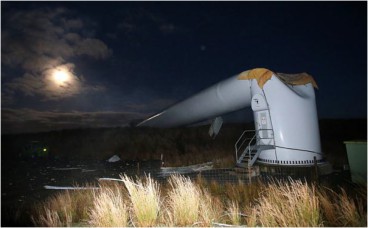An innovative new single-blade wind turbine to change the landscape of offshore wind energy

The global renewable energy production is currently at a mere 11%, which is far below the required 60% target to achieve net-zero emissions by 2050. Achieving this goal requires international cooperation and also revolutionary innovations to speed up the adoption of renewable energy. Fortunately, Touchwind, a Dutch company, has introduced a game-changing design for a floating offshore wind turbine that has the potential to play a crucial role in this endeavor.
This innovative turbine reduces the production costs and eliminates the need for expensive active blade-pitch control systems. Unlike traditional turbines, which need to shut down during high winds, Touchwind's creation can withstand winds of up to 70m/s (i.e. 252 km/h), leading to reduced downtime and increased energy production. The true impact and viability of this groundbreaking design on the offshore wind industry will become increasingly evident as it undergoes further development and testing.
The central concept of Touchwind's pioneering turbine design revolves around a buoyant barrel float firmly anchored to the seabed. Suspended beneath it is a substantial floating buoy. The single blade is fixed to the mast at a slight upward angle and remains above the water's surface when winds are calm. As wind speeds increase, the blade becomes active, spinning and creating lift that straightens the mast. In strong winds, the blade adopts a nearly horizontal position, limiting its rotation speed.
What makes this design exceptional is its ability to adapt to wind direction, effortlessly floating and aligning itself optimally with the prevailing winds. Touchwind claims that the turbine can be easily manufactured and deployed from harbors equipped to handle the substantial 200-meter (656-foot) blade required for a 12-megawatt turbine. Encouragingly, the company has already successfully tested prototypes, both on land and on floating platforms.
Touchwind's addresses several critical challenges related to cost-effectiveness, operational uptime, and installation feasibility. By tapping into previously untapped offshore wind resources in deep-sea locations, this innovation can make a substantial contribution to clean energy generation, while minimizing disruptions to local communities and the natural environment.
Sources: wonderfulengineering.com, newatlas.com
Image Gallery
Want to read more like this story?

Minimising the Levelised Cost of Energy (LCOE) in Offshore Wind Using Digital Workflows
Jun, 06, 2022 | EventThe offshore wind market has never been as exciting or dynamic as it is today. With aggressive carb...
Wind engineering
Sep, 07, 2023 | EducationWind engineering is a branch of engineering that focuses on studying the effects of wind on various...

Wind turbine blades future after the end of their functioning period
Feb, 14, 2020 | NewsSince wind turbines blades cannot be recycled, a question that arises is what happens to them after...

Wind turbines destroyed in Evia, Greece
Jan, 13, 2020 | NewsWind turbines came crashing down due to high winds in Evia, the second-largest island in Greece. S...

80-meter wind turbine collapses in Northern Ireland
Jan, 14, 2015 | NewsA massive wind turbine has mysteriously collapsed on January 2nd, on Murley mountain in Northern Ire...
Wind tunnel
Sep, 07, 2023 | EducationConducting wind tunnel experiments, engineers or researchers can predict the behavior of a structu...

Wind turbines collapse in Brazil
Sep, 10, 2019 | NewsTwo wind turbines have collapsed in less than two months in Brazil. The facilities were prod...

Scotland’s largest offshore wind farm: first power generation was announced
Aug, 23, 2022 | NewsSSE Renewables, and its partner Total Energies have announced first power generation from the Seagr...

London changes skyscraper building regulations in fear of high winds in the streets
Aug, 29, 2019 | NewsThe city of London has tightened the rules on the construction of skyscrapers to prevent creating an...
Trending

Spectacular interchanges around the world

Building partially collapses in Philippines: 2 people injured

Concrete Component Design Using STAAD.Pro

World’s most famous steel structures

Eshima Ohashi bridge in Japan designed for the brave!

Underground tunnel and Yonge Station project in downtown Toronto

Detroit (U.S. state of Michigan): New skyscraper reached its final height at 207m



